Cactus Spotlight: Mastering Indoor Growing Conditions
If you’ve ever struggled to keep an indoor cactus alive, you’re not alone. While these desert dwellers have a reputation for being low-maintenance, they won’t thrive unless you understand their unique needs. From selecting the perfect sun-soaked spot to mastering the art of proper watering, successful indoor cactus care requires attention to several key factors. You’ll discover that these fascinating plants can flourish in your home environment when you provide the right conditions—and the journey to creating your own thriving indoor desert oasis starts with understanding the essential elements of cactus cultivation.
Contents
Light and Placement
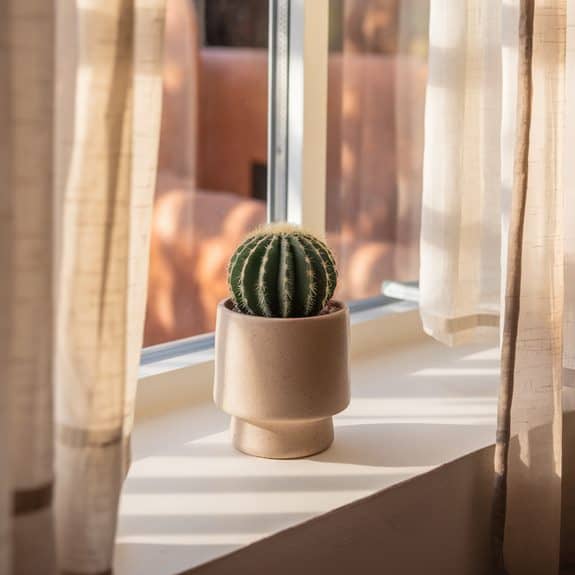
Most cacti need bright, direct sunlight for at least 4-6 hours daily to thrive indoors. You’ll want to place your desert companions near south or west-facing windows, where they’ll receive the strongest light.
If you notice your cactus stretching or leaning, it’s seeking more light. During winter’s darker days, you might need to supplement with grow lights to keep your spiky friends happy.
Soil and Drainage Requirements
While proper lighting sets the stage for cactus growth, the right soil mix plays an equally important role. You’ll need a fast-draining mixture that combines regular potting soil with coarse sand and perlite or pumice.
Make sure your pot has drainage holes and use a 1:1:1 ratio of these materials. This creates the airy, well-draining environment your cactus roots crave.
Watering Your Indoor Cacti
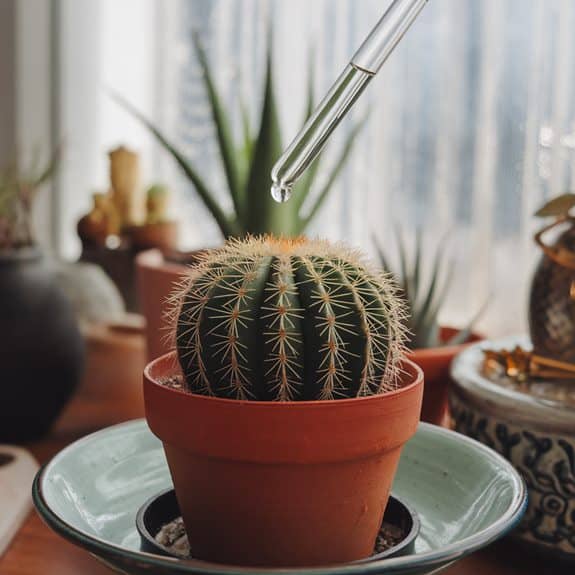
Proper watering is essential for your indoor cacti’s survival, with needs varying dramatically between growing and dormant seasons. You’ll want to water thoroughly during the active growing period in spring and summer, while reducing drastically in fall and winter when most cacti rest.
The most common watering mistakes you’re likely to make include overwatering during dormancy, using a spray bottle instead of deep watering, and failing to adjust your watering schedule based on environmental conditions.
Seasonal Watering Schedule Guide
Successful indoor cactus care depends on adjusting your watering schedule throughout the year. During spring and summer’s active growth period, water your cacti every 7-10 days.
In fall, reduce watering to once every 2-3 weeks as growth slows. Winter requires minimal water – once monthly is sufficient. Always check soil dryness before watering by inserting your finger an inch deep.
Common Watering Mistakes Explained
Despite their hardy nature, indoor cacti often suffer from well-intentioned but misguided watering practices. You’re likely making two common mistakes: overwatering during winter dormancy and using a fixed schedule regardless of environmental conditions.
Don’t fall into the spray bottle trap either – it’s ineffective and can lead to surface root development. Instead, deeply water only when the soil’s completely dry.
Temperature and Humidity Control
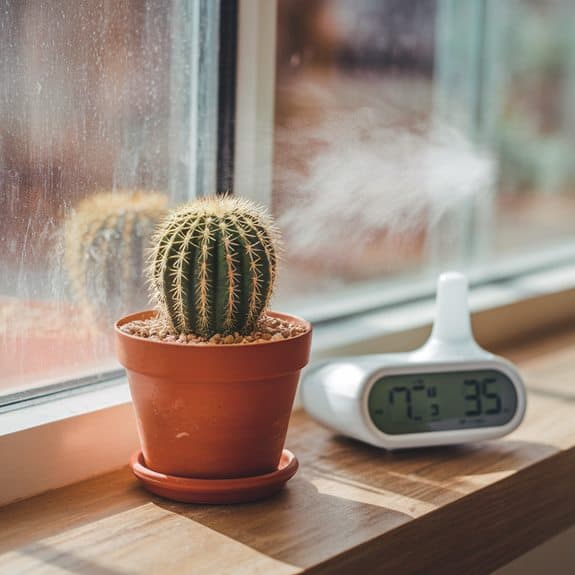
Your indoor cacti will thrive in daytime temperatures between 70-80°F (21-27°C) and nighttime temperatures around 50-60°F (10-16°C), with desert species needing warmer conditions than forest cacti.
You’ll want to provide a slight temperature drop during winter months to mimic natural desert conditions, which helps trigger blooming cycles.
While most cacti prefer low humidity levels of 40-60%, tropical species like Christmas cacti need higher humidity around 60-70% to flourish indoors.
Ideal Temperature Range Numbers
To maintain healthy indoor cacti, you’ll need to provide temperatures between 70-80°F (21-27°C) during the day and 50-60°F (10-16°C) at night. This temperature drop mimics desert conditions, where your cacti naturally evolved.
During winter dormancy, you can keep temperatures slightly cooler, around 65°F (18°C) during the day and 45-55°F (7-13°C) at night.
Seasonal Temperature Care Tips
Maintaining proper seasonal temperature control for indoor cacti requires different approaches throughout the year. During winter, you’ll want to reduce temperatures to 45-55°F at night to mimic their natural dormancy cycle.
In summer, protect your cacti from hot windowsills and air conditioning drafts. You can mist around (not on) your plants during hot months to increase humidity slightly.
Humidity Requirements By Species
Different cactus species thrive in varying humidity levels, building upon their natural desert habitats. Desert cacti like Saguaro and Barrel prefer 30-40% humidity, while tropical varieties such as Christmas and Easter cacti need 50-60%.
You’ll want to maintain these levels by misting tropical species daily, but keep desert varieties drier to prevent root rot and fungal issues.
Selecting the Right Container
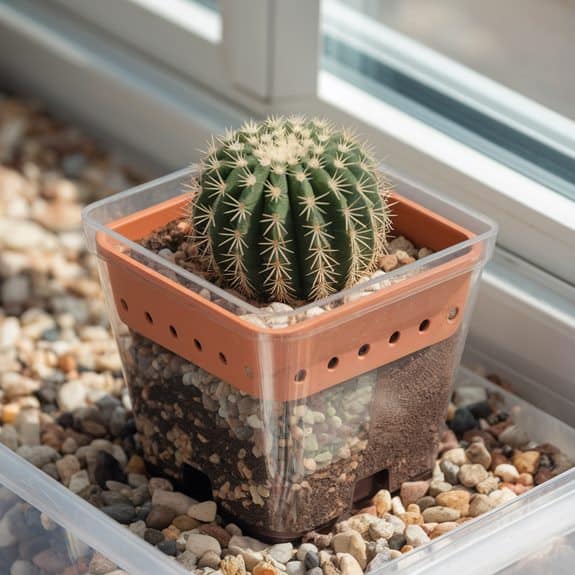
Selecting the perfect container for your indoor cactus starts with three essential factors: drainage, size, and material. Your pot must have drainage holes to prevent root rot, and it shouldn’t be more than 1-2 inches wider than your plant’s root ball.
Choose unglazed terracotta or ceramic pots – they’re porous and help excess moisture evaporate through their walls.
Feeding and Fertilizing Tips
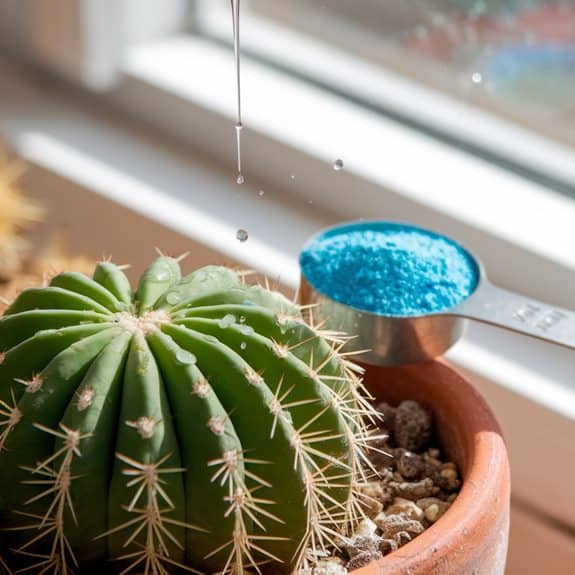
Providing nutrients to your indoor cactus requires a light touch, as these desert plants don’t need frequent fertilizing. Feed your cactus with a diluted, balanced fertilizer (10-10-10) during its growing season, typically spring and summer.
Apply fertilizer once every four to six weeks, and stop feeding completely during fall and winter when your plant enters its natural dormancy period.
Common Pests and Prevention
While proper nutrition helps maintain healthy cacti, pest prevention requires equal attention.
You’ll need to watch for mealybugs, spider mites, and scale insects, which commonly attack indoor cacti. Check your plants weekly for white cottony masses, webbing, or brown bumps. If you spot these pests, isolate affected plants immediately and treat them with neem oil or insecticidal soap.
